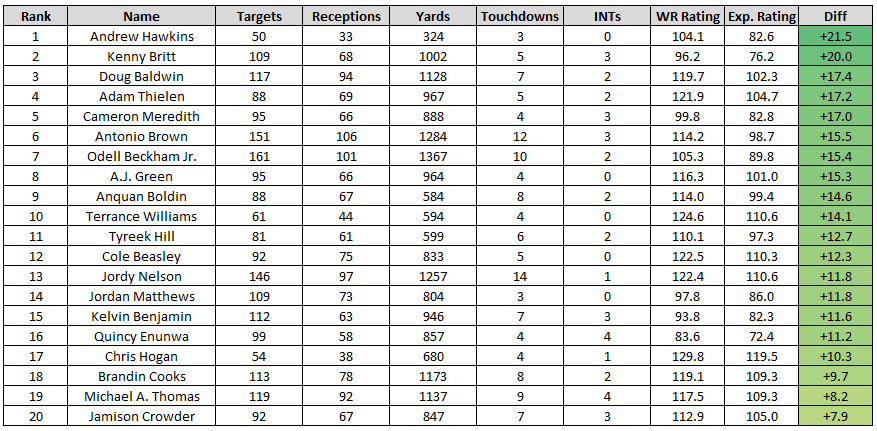As the final part of my series on wide receiver efficiency, I wanted to look at WR Rating (the passer rating of a player’s quarterbacks when that player is targeted.) However, since it correlated poorly to volume in the following season, I tried to improve on it by adjusting for quarterback play.
The question I asked myself was this: Whose WR Rating is more impressive, Dez Bryant's 106.8 or Kenny Britt's 104.1? At surface level, Bryant’s appears more impressive, but that isn’t the case when factoring in Dallas quarterbacks averaged a 102.5 passer rating while Los Angeles quarterbacks averaged an abysmal 70.5.
When we talk about wide receiver efficiency, it’s not just that “this wide receiver was x efficient on these targets,” but rather, “the connection between this quarterback and this wide receiver was x efficient on these targets.” Clearly, a wide receiver catching passes from Aaron Rodgers or Drew Brees has a much greater chance at efficiency than one catching passes from Ryan Fitzpatrick or Brock Osweiler. This statistic (adjusted WR Rating) helps illustrate just how efficient a team’s wide receiver was independent of quarterback play.
In this metric, we’re contrasting expected passer rating (average passer rating from each quarterback across all of a wide receiver’s 2016 targets) with WR Rating (the resulting passer rating on the totality of that wide receiver’s targets). For this exercise, spikes and throwaways have been removed from our sample.
Top 20
Andrew Hawkins, New England Patriots – Although Hawkins was very efficient last season, it’s hard to get excited about a 31-year-old wide receiver who has never finished better than WR48. He joins a crowded offense in New England and likely shouldn’t be on anyone’s fantasy radar, barring a potential injury to fellow slot receiver Julian Edelman.
Kenny Britt, Cleveland Browns – Britt was the lone bright spot on the Rams offense last season. Britt has minimal target competition heading to Cleveland, and I like his chances of outscoring Corey Coleman, who ranked poorly by a number of different efficiency metrics.
Exclusive content for premium subscribers

WANT TO KEEP READING?
Dominate Fantasy Football & Betting with AI-Powered Data & Tools Trusted By All 32 Teams
Already have a subscription? Log in




 © 2025 PFF - all rights reserved.
© 2025 PFF - all rights reserved.